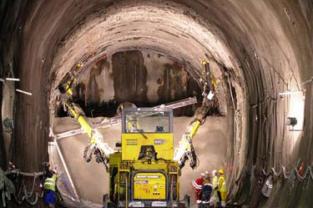The soil-testing campaign for the future base tunnel of the new Lyon-Turin high speed train service consists in excavating 4 declines, including that of Saint-Martin-la-Porte.
The declines join the route of the future base tunnel and are extended by galleries. They provide information about the geology and technical difficulties to be anticipated for the construction of the future tunnel, and will be used as ventilation and access galleries during the construction and operationphases.
The Saint-Martin-la-Porte decline starts 7 km away from the French portal of the future base tunnel. It joins the route of the future tunnel at 600 m depth, after 2 km of excavation. The lateral support is permanent and designed for a lifetime of 15 years.
The works started early May 2003.
The decline crosses successively: a scree cone, the carbonated soils of the Perron des Encombres unit (limestone, marl and dolomite), the coal face (anhydrites and gypsums), the productive coal (sandstone and coal shale).
The issues on the project are:
- poor background and initial data on these soils,
- large depth.
They require:
- characterisation of soils on progress,
- monitoring of the structure behaviour,
- continuous adjustment of excavation and support methods with respect to observations and new data.
Terrasol’s achievements:
TERRASOL was assigned with the detailed design and geotechnical assistance for the contractor:
- Summary of initial geotechnical data and predictions;
- Design of the open air arch and protection devices against block falls;
- Design of the tunnel support, monitoring of tests and inspections, back-analysis, technical advices, study of potential adjustments.
 Agent Access
Agent Access 




